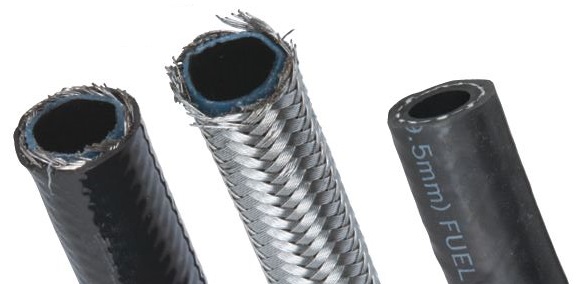
In the context of automotive plumbing, permeation refers to the molecular penetration of gases, vapors, or fluids through a barrier. This process is determined by the thickness and type of materials used.
It’s important to understand the compatibility of fluid with the hose material. Each hose differs in lifespan, maximum pressure, weight, flexibility, abrasion resistance, ease of assembly, and budget.
Choosing the wrong hose can result in fuel odor, leaks, and accelerated liner deterioration. Research is the key to successfully assembling any fluid transfer system.
To give you a better idea of what different hose options are available to you (and what applications they’re best suited for), let’s take a look at some of the hoses made by Fragola Performance Systems.
***
Series 3000 Stainless Race Hose

- CPE synthetic rubber liner with a braided stainless steel cover
- Compatible with all lubricants and most fuels with some fuel vapor permeation
- Commonly used with dry sump systems, oil lines, and racing fuel systems
- Up to 1,500 psi working pressure depending on size
- Limited life with alcohol-blended fuels
***
Premium Black Nylon Race Hose

- CPE synthetic rubber liner with a braided black nylon cover
- Compatible with oil, fuels, coolants, and alcohols with some fuel vapor permeation
- Commonly used with dry sump systems, oil lines, and racing fuel systems
- 500 psi max working pressure
- Limited life with alcohol-blended fuels
***
EZ Street Hose

- Budget-friendly and flexible nitrile-based liner blocks 99% of hydrocarbon fuel vapors
- Commonly used with modern pump gas, diesel, and alcohol-blended fuels
- Available in -6 and -8 AN sizes
- Handles up to 175 psi when used with compatible push-on fittings and stainless steel squeeze clamps
***
Series 6000 PTFE-Lined Hose

- Smooth-bore PTFE liner with a braided stainless steel or black thermoplastic cover
- Resists corrosive fluids
- Commonly used with brake systems, oil, nitrous, power steering, and alcohol-based fuels with near-zero permeation
- Up to 3,000 psi working pressure depending on size
***

Comments